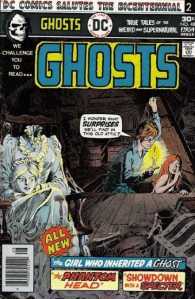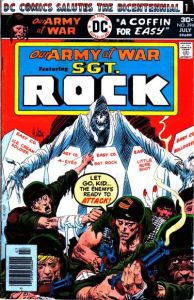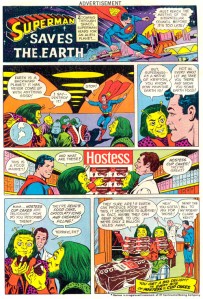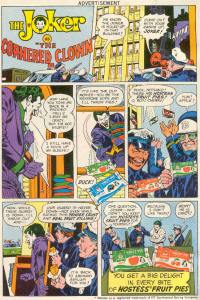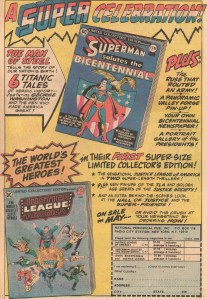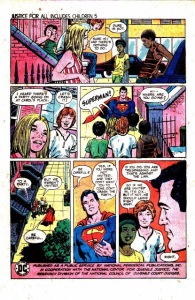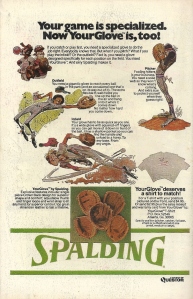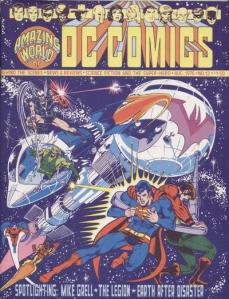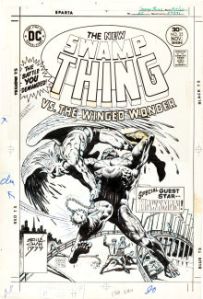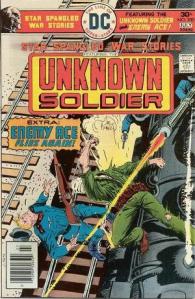DC SALUTES THE BICENTENNIAL
Part Two: The Leftovers
Collect 25 of 33 DC comic book headings with the special Bicentennial cover and you will be sent a free Superman belt buckle!
Even back then I wasn’t too thrilled to get the belt buckle. But the comics? They, not the buckle, were the goal.
These were comics cover dated July and August 1976, which meant they were released in April or May of that year.
At my count there were 48 series released by DC those months. Earlier in 1976 DC cancelled some series that I loved (like Phantom Stranger and Stalker) and that fall they would release an explosion (I know, I know, I was uncomfortable using the words “DC” and “explosion” in the same sentence…) of titles – some of which sound familiar even to casual or modern fans (Welcome Back Kotter, Isis, Starfire, Superfriends, Ragman and the revival of Green Lantern). Warlord started its classic run in February 1976 but took a hiatus during the summer and was brought back that fall. Shazam and House of Secrets both released issues in March and then September - a six-month hiatus. Young Love had them all beat - releasing an issue that January and not another until December of 1976.
In July and August (I will hereafter use the cover dates), along with regular-size comic books DC also released three of their Limited Collector’s Editions. These were large-size comics (tabloid-size: a regular comic unfolded and turned on its side). At that point these comics featured all reprints. They were #45 (Secret Origins Super-Villains), 46 (Justice League) & 47 (Superman Salutes the Bicentennial). #47 was particularly notorious for featuring Superman only on the cover. The interior stories featured reprints of the Revolutionary War character Tomahawk.
In July 1976 DC released Amazing World of DC Comics #12, a “fanzine” featuring interviews and coming attractions. This issue focused on science fiction-ish comics (Green Lantern, the Legion, Earth After-Disaster, etc.) and featured a nifty Mike Grell cover.
DC also released Charlton Bullseye #5 in July with art by Alex Toth and John Byrne (in separate stories), but it wasn’t really part of the DC pantheon. It being ignored made some sense. But still - why not? I guess they wanted to make collecting the headings easier, not harder.
These larger comics and fanzines were harder to find for the average kid and I understand why DC did not include them in the 33.
But why not the others? Why didn’t every issue of the line feature the Bicentennial heading? No amount of my internet trolling can find the answer. Does anyone know?
It’s not because the issues missed were too expensive. Yes, some were fifty cents, but so were some of the 33. Some of the comics left out weren’t exactly the best-sellers, but neither were some of the 33. Sales may have had a bigger impact than I let on – some of the comics left off the list were real stinkers.
Which July and August 1976 DC comics did not have the Bicentennial heading?
Swamp Thing #23. This was the last issue of this iconic series. It was also the first issue I owned of Swampy’s adventures, ironically. It ended on a cliffhanger and Hawkman was touted to appear in #24, and even mentioned on DC’s “Daily Planet” – a one-page house ad made to look like a newspaper hyping upcoming issues. The cover and some page lay-outs of issue #24 can be found online. Is the complete story somewhere in DC’s dark basement?
Witching Hour #64. Only the most die-hard Marvel troll would disagree that, although Marvel frequently out-did DC in the superhero department, DC did some fine horror-titles. Still, this was one of their lowest sellers.
Flash #243. What!? Flash was third only to Superman and Batman back then – the concept of a “trilogy” with Wonder Woman was a modern-era creation – a poll of Justice League members in the late 1970s didn’t even place her in the top five. Why wasn’t Flash given a Bicentennial heading? Sure, it wasn’t their best selling comic, but … Flash no, Plop yes? Wha...?
Perhaps it was because of DC Super Stars #5. It had a bicentennial cover and featured Flash reprints. Too much of the Scarlet Speedster, perhaps?
Kobra #3. This was a great series, but sold dismally for its seven issues despite a unique premise (especially for DC) – twin brothers who shared a telepathic link. Injure one, the other feels it. Too bad one of them is the leader of a murderous cult bent on world domination. Great pulpy fun!
DC Special #22. New stories of the Three Musketeers and reprints of Robin Hood from Brave & Bold.
Star-Spangled War Stories #200. Another baffling omission. Our Fighting Forces gets a Bicentennial heading but not SSWS? Featuring the Unknown Soldier, this book focused more on WWII spy thrillers than DC’s other war books (another genre at which DC arguably excelled over Marvel). The Unknown Soldier was (in my opinion, if not sales) second only to Sgt. Rock, with the Haunted Tank a close third (it was actually the other way around - Rock, then the Tank, then the Unknown Soldier).
And the July 1976 issue was #200! Two. Hundred. Captain America #200 was published in August of 1976 and Marvel milked that for all it was worth.
This issue featured not only the Unknown Soldier but also Enemy Ace.
Did its letter column even mention the wonderful synergy of cover date/issue number and content (what a better way to celebrate America’s birthday than by watching the Unknown Soldier cold-cock a Nazi on a moving train)? Boy did DC drop the ball on THIS one…
Super-Team Family #5. Part of the “family” series of books – this one featured reprints of teams and team-ups with a few new tales scattered about. Soon they would change format to feature new tales of the Challengers of the Unknown. Later they would change formats again to feature new team-ups – the first four issues of the new format focusing on the Atom’s hunt for his kidnapped wife. An excellent story arc that needs to be gathered into a trade paperback! Issue #5 features all reprints, including the Batman-Eclipso team-up from Brave & Bold.
Hercules Unbound #5. DC’s version of the man-god awoke after centuries to Earth-After-Disaster. Later issues had superb art by Walter Simonson.
Metal Men #46. A series long past its prime that would limp along for another year or so, although I thoroughly enjoyed its last two years of issues. They featured Walt Simonson covers and interiors, with some interiors by current Dick Tracy artist Joe Staton and covers by legendary Jim Aparo.
Plastic Man #13. Plas was originally a character with Quality Comics during the Golden Age and purchased by DC along with the Blackhawk, GI Combat, the heroes who would eventually become the Freedom Fighters, etc. Plas’ first DC comic lasted ten issues in the 1960s and this revival (beginning with issue #11) also lasted ten issues – folding in 1977. Great art by Ramona Fradon throughout this second run. This issue was written by Steve Skeates!
Superman Family #177. All right, enough! They left out a Superman book. A. Superman. Book! With sales flagging, the Superman division of National combined three of their books – Superman’s Pal, Jimmy Olsen, Superman’s Girlfriend, Lois Lane and Supergirl into one book rotating the three stars. A new story for one of the stars and reprints for the other two. Of all the “family” books this was the most successful – publishing into the 1980s.
Wonder Woman #224. The (still) beautiful Linda Carter-starring TV show was a big hit at this time, but despite that, until the mid-1980s, the Wonder Woman comic was a bit of a sales bomb - middling at best. National tried to boost her sales - just years before they got some publicity by stripping her of her super-powers and turning her into more of a Diana Riggs than a Diana Prince. In years to come there were excellent stories featuring art by the legendary Gene Colon (these were the issues before #300). But despite low sales they kept the series going so they wouldn’t lose their copyright on the character. DC eventually bought the character outright in the late 1980s which was also when her fortunes started to turn and the character become the iconic powerhouse it is now. Coincidence? Um, sure… Anyway, this issue features art by Curt Swan, doing a rare non-Superman-related title. The next issue is of more interest - Wonder Woman fights off “black lightning” on the cover. Not the inspiration for Tony Isabella’a character debuting within a year, but an interesting coincidence.
Did I miss any?
***
Why not put Bicentennial headings on all their books? And why decide on 33? What was the significance of that number or those particular issues?
Choosing which of the 33 would have been a tough choice, and any book selected or rejected could have been debated and argued. I hope that was the case and the editors or whoever was involved didn’t just pick books from the top of the list.
Why not include low-selling books to help its sales - like Swamp Thing? They had the next-issue blurb as the last panel; so why not boost sales for one last issue?
Why not push up the publication of Starfire, or better still, Ragman - which debuted with a September cover date - and introduce them to new readers who may have otherwise passed on the books.
Why not move the publication of Green Lantern #90 up one month? The original run of the Silver Age Green Lantern ended with #89 – which was also the last issue of the iconic Denny O’Neil/Neal Adams “hard riding heroes” epic. This moniker was given to the “arc” much later. Denny O’Neil again wrote the revived title with Mike Grell as the new artist. The series lasted into the 1990s. You KNOW the issue was in the can by the time of the bicentennial promotion. Its cover declared, “At Last! The Return of the Greatest Comic of Them All!” Not great enough to merit a Bicentennial heading obviously…
Or would that be “too much” publicity? A big bicentennial promotion PLUS adding two new comics to the shelves? Oh, no, no, no, no...
C’mon! If Marvel had done it, they would have done it better– as was usual with their business acumen of superhero books in the 1970s. Youngsters would be frothing at the mouth to get their hands on Kobra or Plastic Man and eagerly snapping up the new titles Starfire, Ragman and Green Lantern. Newsstand owners would be shooing kids off with brooms as the brats tore the headings off to GET THAT BELT BUCKLE!!!
But these 12 comics above were not among the 33 chosen to represent DC’s Bicentennial celebration. We may not like it, but we have to accept it.
***
My reviews of the chosen 33 will start soon, but first, a word from our sponsor...
All comic covers, advertising, characters and images are the property of their respective copyright holders and reprinted here for your entertainment and review under the Fair Use Doctrine as commentary, criticism and ... sometimes ... parody.
Keep in mind the actual creators probably only received a fraction of their creative worth at the time of their creation ... but that is a whole other story...
Original Material Copyright 2015 Michael G Curry
